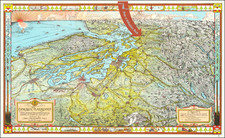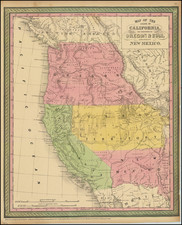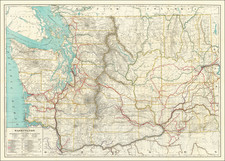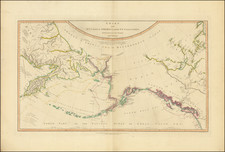Donation Land Claims -- One of the Earliest Printed Maps of Cowlitz County
Unrecorded separately published map of Cowlitz County, published in Seattle, replete with dozens of the earliest pioneer claims dating back to Oregon Territory Donation Land Law, pre-dating the creation of Washington Territory.
The map depicts the county, which has been nearly completely subdivided into townships, except for the areas immediately west of St. Helens. Four diffeent sections are marked in red by an early owners, along with an extension of the road to the Lewis River from Martin's Bluff, which suggests a crossing at that point.
The map locates the Donatlion Land Claims of a number of early Oregon land owners along the major rivers, including Columbia River, Cowlitz River and the lower Lewis River and Kalama River, These claims date back to the earliest Pioneer settlers in Washington Territory, including
The map notes that the Washington Map & Blue Print Company were the Successor to O.P. Anderson Map and Blue Print Company, which was originally established in 1885 in Seattle. The inside cover includes a list of about 40 other maps published by the company, including a wall map of Seattle and 4 Alaska Gold Rush maps.
Oregon Donation Land Law of 1850
The Oregon Donation Land Law in 1850, the law legitimized the 640-acre claims provided in 1843 under the Oregon Provisional Government, with the proviso that white male citizens were entitled to 320 acres and their wives were eligible for 320 acres. For citizens arriving after 1850, the acreage limitation was halved, so a married couple could receive a total of 320 acres. To gain legal title to property, claimants had to reside and make improvements on the land for four years.
The law set a two-year window for surveying lands open for claims, but Congress amended the law twice. In 1853, the rights of widows to land claims was added, and the law was extended until 1855 to address complaints about the slow progress in surveying lands. In 1854, Congress again amended the law by reducing the residency requirement from four years to one year.
Cowlitz County
The name Cowlitz was taken from that of a local Native American name, Cow-e-lis-kee.
Cowlitz County, Washington Territory (which was part of the Oregon Territory until 1850) was first settled by non-Native Americans by the Hudson Bay Company, at at a time when the British were still claiming the boundary with the United States as the Columbia River and the region was neutral territory. In 1844, the Oregon Territorial government created Clark County out of the Vancouver District (which comprised most of what is now Western Washington and British Columbia). In 1845, Lewis County was created from Clark County. From Lewis, four other counties were created: Pacific (1851); Thurston (and later Pierce; 1852); Cowlitz (1854) and Wahkiakum (1854).
One of the first settlers in the Cowlitz County region was Peter Crawford, one of the first important surveyors in the Oregon Territory. His donation land claim was near the present-day site of Kelso (shown on the map). The Cowlitz, Lincoln and Columbia Rivers became the sites of numerous settlements. The first school was built in Monticello (near present-day Longview) in the Fall of 1850. The school was built by Alexander and Nathaniel Stone, Harry Darby Huntington, Seth Catlin, Jonathan Burbee and Peter Crawford (all identified on the map). The first teacher was Fredrick Huntress.
On November 25, 1852, at Harry Darby Huntington's home in Monticello (H.D. Huntington's Donation Lands are shown on the map), the Monticello Convention was signed, asking for the establishment of a Washington Territory. Among the signers were Huntington, Seth Catlin, Nathaniel Stone, Jonathan Burbee, Peter Crawford and Alec Crawford (all shown on the map)). The Monticello Convention was forwarded to the U.S. Congress, who ratified the convention, with the one exception that the territory be named Washington instead of Columbia.
Upon the creation of Washington Territory, Isaac Stevens was appointed the first governor. Hunt and Kaylor (p. 446) described the establishment of Cowlitz County: "Famous old Monticello became the county seat of Cowlitz County when the Legislature on April 1, 1854, adopted the bill introduced by H. D. Huntington March 8. Thomas Roe, Alexander S. Abernathy and Taylor Rue were the first commissioners; Charles Holman, auditor; Alexander Crawford, treasurer; James Huntington, sheriff; Nathaniel Ostrander, probate judge; Benjamin Huntington, assessor; Nathaniel Stone and W. H. Harris, justices of the peace."
Rarity
The map is unrecorded. O.P. Anderson issued a map of the Cowlitz County in the same size and format which survives in 2 examples in the Washington State Library and Library of Congress (also a blue print map).
We note only the OP Anderson map of Cowlitrz County as printed before this map.
Blueprint & Blue Line maps (Cyanotype Printing)
Blueprint and blue line maps were among the most popular means for the swift printing of maps for which there would be a limited demand. A blueprint or blue line map could be made and/or revised much more quickly than a lithograph, cerograph, or other printing method, and at a much lower cost.
This method of printing was invented in 1842 by John Herschel, a chemist, astronomer, and photographer. A cyanotype process, one starts by drawing on semi-transparent paper, weighted down by a top sheet of paper. The paper would be coated with a photosensitive chemical mixture of potassium ferricyanogen and ferric ammonium citrate. The paper would then be exposed to light, wherein the exposed portions turned blue and the drawn lines, protected from exposure, would remain white.
The cyanotype printing process was an improvement on the expensive and time-consuming method of hand-tracing original documents. The technique was particularly popular with architects; by the 1890s, a blueprint was one-tenth the cost of a hand-traced reproduction. It could also be copied more quickly.
Blueprint and blue line maps began to appear as early as the 1850s and 1860s, but they really began to become the standard for mining and similar limited-purpose maps by the 1880s. The ability to create these maps quickly and at a low cost made them the standard for short-run prints, ideal for mapping mining regions in the West and for similar purposes.
The method still exists today, but in a very limited fashion. In the 1940s, diazo prints (whiteprints or bluelines) became more popular, as they were easier to read and faster to make. The blue lines on a white background of these prints are now what most people call blueprints.













![[ Port Madison Indian Reservation - West Port Madison ] 1907 Kitsap County Atlas Township 26 North, Range 2 East, W.M.](https://storage.googleapis.com/raremaps/img/small/101544.jpg)

![[California / Washington / Oregon] Pacific Highway Maps](https://storage.googleapis.com/raremaps/img/small/89058.jpg)
